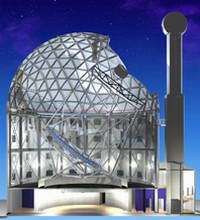Africa's 'Giant Eye' opened

The southern hemisphere's largest telescope was officially unveiled yesterday by the South African President Thabo Mbeki in Sutherland, a small town 400km north of Cape Town, South Africa. The Southern African Large Telescope (SALT) - also known as Africa's Giant Eye - is a new ground breaking project which will enable astronomers from six countries to study more closely the lives of stars and the origins of the universe.
Image: SALT through view. Credit: SALT
The Southern African Large Telescope (SALT) - also known as Africa's Giant Eye - is a new ground breaking project which will enable astronomers from six countries to study more closely the lives of stars and the origins of the universe. The gigantic telescope with its 11-metre-wide mirror will also be a truly 21st century facility, with researchers able to submit observing requests and receive data back via the internet, meaning they will not have to travel to South Africa to use the telescope.
Speaking at the official opening, South African President Thabo Mbeki said: "SALT means that our country will remain at the forefront of cutting-edge astronomical research. The telescope will enable us to observe the earliest stars and learn about the formation of our galaxy which will help us reveal clues about the future."
"We are also proud that SALT will not only enable Southern African scientists to undertake important research, but also provide significant opportunities for international collaboration and scientific partnerships with the rest of the world."
South Africa has a proud history of excellence in astronomy dating back to 1820 when the first observatory was built in Cape Town, and SALT is the biggest science project undertaken by the new South Africa.
The $20 million project is an international partnership backed by six different countries.
Professor Gordon Bromage, Chairman of the UK SALT Consortium and Head of Astrophysics at UCLan, commented: "SALT is a hugely significant project, incorporating innovative designs and magnificent engineering. It will provide astronomers with a window into the realms of planets around other stars and the origins of galaxies, which will surely lead to many exciting discoveries."
"This is particularly true given telescopes of this size and power are needed in both hemispheres to get an accurate picture of stars and galaxies. For example, one can only see our two nearest galaxies, the Magellanic Clouds, from the southern hemisphere."
Limited scientific observations have already begun while completion of the telescope's commissioning continues over the coming months. In the near future installation will begin of the Prime Focus Imaging Spectrograph, which will allow astronomers to dissect and then analyse the dim light of distant stars and galaxies in dozens of different ways, some of them not available on any other large telescope.
SALT science programmes will include studies of the most distant and faint galaxies to observations of asteroids and comets in our own solar system. The facility has been completed within the five year deadline and has been delivered on budget.
Source: PPARC















